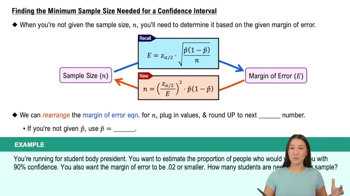In Exercise 28, the population mean weekly time spent on homework by students is 7.8 hours. Does the t-value fall between -t0.99 and t0.99?
Table of contents
- 1. Intro to Stats and Collecting Data1h 14m
- 2. Describing Data with Tables and Graphs1h 55m
- 3. Describing Data Numerically2h 5m
- 4. Probability2h 16m
- 5. Binomial Distribution & Discrete Random Variables3h 6m
- 6. Normal Distribution and Continuous Random Variables2h 11m
- 7. Sampling Distributions & Confidence Intervals: Mean3h 23m
- Sampling Distribution of the Sample Mean and Central Limit Theorem19m
- Distribution of Sample Mean - Excel23m
- Introduction to Confidence Intervals15m
- Confidence Intervals for Population Mean1h 18m
- Determining the Minimum Sample Size Required12m
- Finding Probabilities and T Critical Values - Excel28m
- Confidence Intervals for Population Means - Excel25m
- 8. Sampling Distributions & Confidence Intervals: Proportion1h 25m
- 9. Hypothesis Testing for One Sample3h 57m
- 10. Hypothesis Testing for Two Samples4h 50m
- Two Proportions1h 13m
- Two Proportions Hypothesis Test - Excel28m
- Two Means - Unknown, Unequal Variance1h 3m
- Two Means - Unknown Variances Hypothesis Test - Excel12m
- Two Means - Unknown, Equal Variance15m
- Two Means - Unknown, Equal Variances Hypothesis Test - Excel9m
- Two Means - Known Variance12m
- Two Means - Sigma Known Hypothesis Test - Excel21m
- Two Means - Matched Pairs (Dependent Samples)42m
- Matched Pairs Hypothesis Test - Excel12m
- 11. Correlation1h 24m
- 12. Regression1h 50m
- 13. Chi-Square Tests & Goodness of Fit2h 21m
- 14. ANOVA1h 57m
7. Sampling Distributions & Confidence Intervals: Mean
Confidence Intervals for Population Mean
Problem 6.2.13
Textbook Question
In Exercises 13 and 14, use the confidence interval to find the margin of error and the sample mean.
(14.7, 22.1)
 Verified step by step guidance
Verified step by step guidance1
Step 1: Understand the problem. The confidence interval is given as (14.7, 22.1). The goal is to find the margin of error and the sample mean. The confidence interval represents the range of values within which the true population parameter is expected to lie.
Step 2: Recall the formula for the margin of error. The margin of error (E) is half the width of the confidence interval. Mathematically, it is calculated as: .
Step 3: Recall the formula for the sample mean. The sample mean (\(\bar{x}\)) is the midpoint of the confidence interval. Mathematically, it is calculated as: .
Step 4: Substitute the given values into the formulas. For the margin of error, substitute 22.1 as the upper limit and 14.7 as the lower limit into the formula for E. For the sample mean, substitute the same values into the formula for \(\bar{x}\).
Step 5: Simplify the expressions to find the numerical values of the margin of error and the sample mean. This will give you the final results.
 Verified video answer for a similar problem:
Verified video answer for a similar problem:This video solution was recommended by our tutors as helpful for the problem above
Video duration:
1mPlay a video:
Was this helpful?
Key Concepts
Here are the essential concepts you must grasp in order to answer the question correctly.
Confidence Interval
A confidence interval is a range of values, derived from sample statistics, that is likely to contain the true population parameter. It is expressed as an interval (e.g., (14.7, 22.1)) and is associated with a confidence level, typically 95% or 99%. This means that if we were to take many samples and build intervals in this way, a certain percentage of them would contain the true parameter.
Recommended video:

Introduction to Confidence Intervals
Margin of Error
The margin of error quantifies the uncertainty associated with a sample estimate. It is calculated as half the width of the confidence interval, representing the maximum expected difference between the sample statistic and the population parameter. In the given interval (14.7, 22.1), the margin of error would be (22.1 - 14.7) / 2 = 3.7.
Recommended video:

Finding the Minimum Sample Size Needed for a Confidence Interval
Sample Mean
The sample mean is the average of a set of values obtained from a sample, serving as an estimate of the population mean. It is calculated by summing all sample values and dividing by the number of observations. In the context of the confidence interval, the sample mean can be found as the midpoint of the interval, which is (14.7 + 22.1) / 2 = 18.4.
Recommended video:

Sampling Distribution of Sample Proportion

 4:48m
4:48mWatch next
Master Population Standard Deviation Known with a bite sized video explanation from Patrick
Start learningRelated Videos
Related Practice
Textbook Question
40
views
